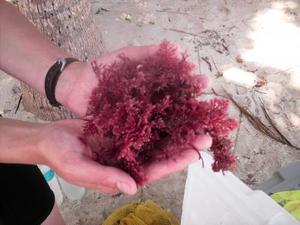EpidemicsMalaria increasingly resistant to drugs, seaweed could be the answer
Researchers recently found a natural substance that can destroy the malaria parasite; the substance is from a red seaweed found off the island of Fiji; the discovery of the substance comes at a much needed time as malaria has developed increasing resistance to existing drugs; the new substance comes from a chemical that that the plant uses to defend against marine fungi; it is entirely different than existing drugs and could be the key against fighting drug-resistant strains of malaria; the substance must still undergo further laboratory tests before it can be used in clinical trials

Callophycus serratus may combat malaria // Source: esciencenews.com
Researchers recently found a natural substance that can destroy the malaria parasite. The substance is from a red seaweed found off the island of Fiji.
The discovery of the substance comes at a much needed time as the Plasmodium falciparum parasite, which causes the deadliest form of malaria, has developed increasing resistance to existing drugs.
In some areas of the world, strains of malaria have developed resistance to even one of the most powerful anti-malarial drugs currently available, artemesinin, which comes from a shrub used in Chinese herbal medicine. According to Dr. Julia Kubanek, an associate professor at the Georgia Institute of Technology, the seaweed contains a chemical substance called bromophycolide compounds, which the plant uses as a natural defense against marine fungi.
Laboratory tests have shown that the bromophycolides are also effective against the malaria parasite.
Dr. Kubanek said, “The seaweed is marshaling its defenses and displaying them in a way that blocks the entry points for microbes that might invade and cause disease. Seaweeds don’t have immune responses like humans do. But instead, they have some chemical compounds in their tissues to protect them.”
Dr. Kubanek believes that the new compounds will be more effective against malaria than existing drugs as its properties differ from the drugs that malaria has shown increasing resistance to.
“The bromophycolide structural class is unique… there are no antimalarials like it. Even though it looks like the mode of action may be similar to that of chloroquine and other quinine antimalarials, our bromophycolides are effective in vitro against a chloroquine-resistant strain,” she said.
“That means that the resistance mechanism that the parasite has evolved to the quinines does not work against bromophycolides,” she concluded.
The next step for researchers is to test the substance in mammal tissue before clinical trials can proceed.
“We need to show that bromophycolides are effective in a mammalian model, since no in vivo work has been done yet. We may need to design a more potent and more selected derivative, since even in vitro we see effects on non-parasite cells,” she said.
While hopeful, researchers are still uncertain about the efficacy or the feasibility of the new substance as an anti-malarial drug.
“Bromophycolides are not as potent as artemesinin and we don’t yet know how fast they work in humans, or even if they work in humans. So much work is left to be done. But we are hopeful that we will be able to design a strong antimalarial from this lead,” Dr. Kubanek said.
As researchers test this new compound, a deadly new strain of malaria has begun to infect individuals who were previously immune to the disease. Scientists are particularly concerned about this new strain as it has broken the genetic barrier that has protected millions of Africans from malaria.
The new strain was first detected on the island of Madagascar and has begun to spread to east Africa.
